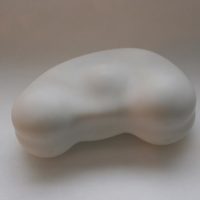iconoclast in marble, artslant new york contemporary art network, 10/07/09
-
k (kidney)
2009 Carrara marble 8 x 4 x 3 in.
Photography by Frederico Sève
By KOAN JEFF BAYSA, M.D. – Originally working in clay, printmaking, and set design in her native Brazil, Angela Freiberger presents works with the complementary convexities and concavities of the human anatomy nestling in sculpted marble, and vice versa. Freiberger’s exhibition, Organs without Bodies, at Frederico Sève Gallery is complemented by photographs, video, and smaller sculptures of internal organs. The exhibition plays off of Zizek’s reversal of Deleuze’s Bodies without Organs (BwO), from Artaud’s 1947 radio play, a concept that addresses the collective potentials in individuals that are activated through “becomings” with other BwOs. The healthy BwO is one that is unfettered by its organ-ness.
This series of vessels was inspired by a scene from Luchino Visconti’s The Leopard (1963), about Sicilian aristocracy on the verge of change, in which a protagonist retreats to a room filled with Roman porcelain vessels designed to hold human waste. Freiberger views these containers as symbols for the loss of power by the monarchy, and in her marble (signifying purity) versions of these vessels, objectifies these articles of quotidian use as lofty receptacles for base purposes. Her recurrent theme of contradiction, of inside and outside (i.e. inside and outside the body), is held within an outside repository (urinal). This concept is further demonstrated by her carving anatomical elements in negative or bas-relief, evaginating internal organs on the external surfaces of her sculptures, inversions of reliquaries and canopic jars. In K (Kidney) (2009), the small rounded almost fetus-like sculpture in marble is smooth and weighty in one’s hands, and the isolated organ invokes its relationship with the surgeon who removed it.
In this current exhibition of Freiberger’s basin and urinal series she stands topologically contrary to the classical subtractive method of taking away and revealing the forms already within the amorphous blocks of stone; rather, from those blocks of stone, she takes away to create outside negative/potential marble forms with spaces into which she can insert an inside human form or parts, usually her own, a circular and synecdochal iteration informed by the intuitive and intimate knowledge of her own body. The works are intensely autobiographical; one incident in particular was iatrogenic: an error during the surgical correction of one problem went undetected and developed into a complication, resulting in the removal of a second organ. Depicted in the photograph UwL&K (urinal with lung and kidney) (2003), the hollowed-out block of pale and cold marble carved in relief with organs is shown back-to-back in apposition to the artist’s seated nude body that reveals a surgical scar.
These assembled works are personal statements by Frieberger that make visually quiet but powerfully loaded statements about the vulnerable but transcendent, oppositional yet complementary, nature of being.
Image: Angela Freiberger, K (Kidney), 2009, carrara marble, 8 × 4 × 3 in. Courtesy of Frederico Sève Gallery/latincollector.
